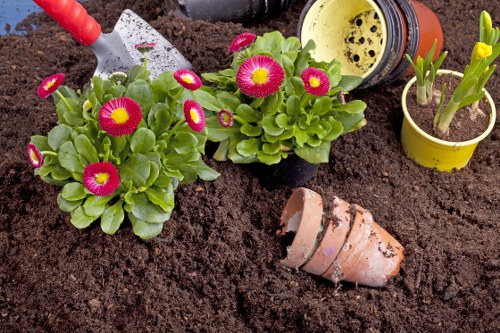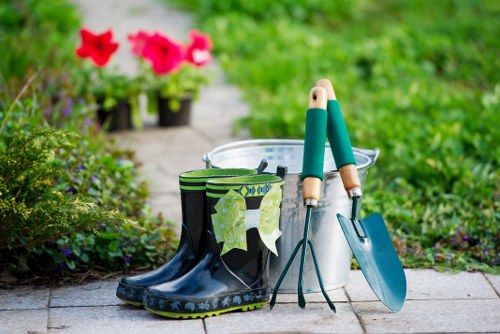Hedge Trimming in Notting Hill
Introduction to Hedge Trimming

Welcome to the vibrant neighborhood of Notting Hill, where picturesque homes and lush gardens create a charming atmosphere. One essential aspect of maintaining these beautiful properties is hedge trimming. Proper hedge trimming not only enhances the aesthetic appeal of your garden but also promotes the health and longevity of your hedges.
In this comprehensive guide, we will explore the importance of hedge trimming, the best practices to follow, and how to find the right services in Notting Hill to keep your garden looking impeccable.
Whether you're a seasoned gardener or a homeowner looking to improve your outdoor space, understanding the nuances of hedge trimming can make a significant difference in your garden's appearance and health.
Why Hedge Trimming Matters

Hedge trimming is more than just a cosmetic procedure. It plays a crucial role in maintaining the structure and health of your hedges. Regular trimming helps in:
- Promoting Growth: Trimming encourages new growth, ensuring your hedges remain dense and healthy.
- Maintaining Shape: Keeping your hedges in the desired shape enhances the overall look of your garden.
- Preventing Disease: Removing dead or diseased branches reduces the risk of infections spreading.
In Notting Hill, where garden aesthetics are highly valued, effective hedge trimming is essential for keeping properties attractive and well-maintained.
Let's delve deeper into the techniques and best practices that can help you achieve the best results.
From selecting the right tools to understanding the optimal timing for trimming, every aspect plays a part in successful hedge maintenance.
Tools and Equipment for Hedge Trimming
Essential Tools

Having the right tools is fundamental to effective hedge trimming. Here are the essential tools you'll need:
- Hedge Trimmers: Available in manual, electric, and gas-powered varieties, hedge trimmers are indispensable for shaping and maintaining your hedges.
- Pruning Shears: For precision cutting of smaller branches and detailed work.
- Loppers: Useful for cutting thicker branches that are beyond the capacity of standard shears.
- Gloves and Safety Gear: Protecting your hands and eyes is crucial when working with sharp tools.
Investing in high-quality tools can make the trimming process more efficient and less labor-intensive.
Additionally, maintaining your tools by regularly cleaning and sharpening them ensures longevity and optimal performance.
Best Practices for Hedge Trimming

Implementing the right techniques can significantly impact the health and appearance of your hedges. Here are some best practices to consider:
- Timing is Key: The best time to trim hedges is during the late winter or early spring before new growth begins.
- Follow the Natural Shape: Trim in a way that complements the natural growth pattern of the hedge.
- Don't Overtrim: Avoid cutting too much at once, as this can stress the plant.
- Regular Maintenance: Regular trimming prevents overgrowth and maintains the desired shape.
By adhering to these practices, you can ensure that your hedges remain healthy, attractive, and well-maintained throughout the year.
Moreover, understanding the specific needs of different hedge species can help tailor your trimming approach for optimal results.
Choosing Professional Hedge Trimming Services

While DIY trimming is possible, professional services often provide superior results, especially for larger or more complex hedges. Here’s why you might consider hiring experts in Notting Hill:
- Expertise and Experience: Professionals have the knowledge and skills to handle various hedge types and trimming techniques.
- Time Efficiency: Hiring a service saves you time and ensures the job is done promptly.
- Proper Equipment: Access to advanced tools and equipment can result in more precise and cleaner cuts.
- Health Assessment: Professionals can identify and address any underlying issues affecting your hedges.
When selecting a hedge trimming service in Notting Hill, consider factors such as reputation, customer reviews, and the range of services offered to ensure you receive high-quality care for your garden.
Additionally, discussing your specific needs and preferences with the service provider can help tailor their approach to meet your expectations.
Contact us today to schedule a consultation and give your hedges the care they deserve.
Maintaining Your Hedge Between Trimmings
Regular Care Tips
Maintaining your hedges between professional trimmings ensures they stay healthy and retain their shape. Here are some tips:
- Watering: Ensure your hedges receive adequate water, especially during dry periods.
- Fertilizing: Use appropriate fertilizers to provide essential nutrients for growth.
- Pest Control: Regularly inspect for pests and treat any infestations promptly.
- Weed Removal: Keep the area around your hedges free from weeds to reduce competition for nutrients.
These maintenance practices contribute to the overall health and appearance of your hedges, making future trimming sessions easier and more effective.
Additionally, integrating these habits into your regular garden care routine can prevent common issues and promote a thriving garden environment.
Seasonal Hedge Trimming Tips
Different seasons require different approaches to hedge trimming. Here's how to adapt your trimming routine throughout the year:
- Spring: Focus on shaping and removing any winter damage to encourage new growth.
- Summer: Perform light trimming to maintain shape and promote air circulation.
- Autumn: Remove spent flowers and prepare hedges for the winter months.
- Winter: Minimal trimming is necessary; focus on protection against frost and snow.
Understanding the seasonal needs of your hedges ensures they remain robust and visually appealing all year round.
Moreover, adjusting your trimming schedule according to the local climate in Notting Hill can enhance the effectiveness of your gardening efforts.
Common Mistakes to Avoid
Avoiding common hedge trimming mistakes can save your hedges from unnecessary stress and damage. Here are some pitfalls to watch out for:
- Overtrimming: Cutting too much at once can weaken the plant and inhibit growth.
- Incorrect Timing: Trimming at the wrong time of year can disrupt the natural growth cycle.
- Using Dull Tools: Dull blades can cause ragged cuts, making hedges more susceptible to disease.
- Neglecting Safety: Failing to wear proper safety gear can lead to injuries.
By being mindful of these common mistakes, you can ensure that your hedge trimming efforts are both effective and safe.
Additionally, seeking professional advice when in doubt can help you avoid these errors and maintain healthy, beautiful hedges.
Eco-Friendly Hedge Trimming Practices
Adopting eco-friendly practices in hedge trimming contributes to a sustainable garden and a healthier environment. Consider the following approaches:
- Using Electric Tools: Opt for electric or battery-powered trimmers to reduce carbon emissions.
- Composting Clippings: Recycle hedge trimmings by composting them to enrich your garden soil.
- Natural Pest Control: Utilize organic methods to manage pests without harmful chemicals.
- Water Conservation: Implement efficient watering systems to minimize water waste.
Integrating these eco-friendly practices not only benefits the environment but also promotes the health and vitality of your hedges.
Moreover, sustainable gardening practices can lead to a more resilient and thriving garden ecosystem in Notting Hill.
Cost Factors in Hedge Trimming
Understanding the cost factors involved in hedge trimming can help you budget effectively. Key considerations include:
- Size of the Hedge: Larger hedges require more time and resources to trim.
- Type of Hedge: Some hedge species are more labor-intensive and may cost more to maintain.
- Frequency of Trimming: Regular maintenance can be more cost-effective than infrequent, intensive trimming sessions.
- Professional vs. DIY: Hiring professionals may involve higher upfront costs but can save time and ensure better results.
By evaluating these factors, you can make informed decisions about your hedge trimming needs and manage your garden budget efficiently.
Additionally, investing in regular maintenance can prevent costly repairs or replacements in the long run.
Local Regulations and Guidelines
When trimming hedges in Notting Hill, it's important to be aware of any local regulations or guidelines that may apply. These can include:
- Height Restrictions: Certain areas may have restrictions on the maximum height of hedges.
- Noise Ordinances: Be mindful of noise levels when using electric or gas-powered trimmers, especially during early or late hours.
- Waste Disposal: Follow local guidelines for disposing of hedge trimmings and other garden waste.
Compliance with these regulations ensures that your hedge trimming activities are lawful and respectful of the community standards.
Consulting with local authorities or hiring professionals familiar with Notting Hill's regulations can help you navigate these requirements effectively.
Enhancing Curb Appeal with Hedge Trimming
Well-maintained hedges significantly contribute to the curb appeal of your Notting Hill home. Here's how you can maximize this impact:
- Consistent Shape: Regular trimming maintains a consistent and attractive shape, enhancing the overall look of your property.
- Healthy Greenery: Lush, healthy hedges create a vibrant and welcoming atmosphere.
- Framing Structures: Use hedges to frame windows, doors, and other architectural features for added elegance.
- Seasonal Decorations: Trimmed hedges provide a perfect canvas for seasonal decorations and lighting.
By paying attention to the details of your hedge trimming, you can elevate the aesthetic appeal of your home and make a lasting impression on visitors and neighbors alike.
Furthermore, attractive hedges can also increase the value of your property, making it a worthwhile investment.
Choosing the Right Hedge Species for Your Garden
Selecting the appropriate hedge species is crucial for achieving the desired look and ensuring ease of maintenance. Consider the following popular options:
- Boxwood: Known for its dense foliage and versatility in shaping.
- Privet: Fast-growing and ideal for taller hedges.
- Yew: Evergreen and highly tolerant of heavy trimming.
- Laurel: Provides thick coverage and has glossy leaves.
Each species has its unique characteristics and maintenance requirements, so choose one that aligns with your garden's needs and your personal preferences.
Additionally, consulting with local gardening experts in Notting Hill can help you select the best hedge species for your specific conditions.
Conclusion
Hedge trimming is a vital component of garden maintenance in Notting Hill, contributing to both the beauty and health of your outdoor space. By understanding the importance of regular trimming, utilizing the right tools and techniques, and considering professional services when needed, you can ensure your hedges remain a stunning feature of your home.
Embrace the art of hedge trimming to enhance your garden's curb appeal, promote plant health, and create a welcoming environment that reflects the charm of Notting Hill.
Book your service now and transform your garden with expert hedge trimming today!